SANTIAGO YAHUARCANI ENTERS THE MoMA COLLECTION
Crisis Galería announced the recent acquisition of the painting Cosmovisión Huitoto (2022) by the outstanding indigenous artist Santiago Yahuarcani by the Museum of Modern Art of New York (MoMA). This extraordinary large format work, made with natural dyes and acrylic paint on llanchama, is one of the largest produced by the artist with more than two meters high and four meters wide.

The work was acquired thanks to a donation from the Latin American and Caribbean Fund of that institution and the Hochschild Correa Collection. This acquisition is fundamental to the history of contemporary Peruvian and Latin American art, as it is MoMA's first acquisition of a work by an indigenous Peruvian artist and the first by an indigenous artist of this size.
Cosmovisión Huitoto is a central piece in Yahuarcani's vast career, exploring various aspects of Huitoto life. Intricately and profoundly composed, the work portrays the culture of his native community, which has endured despite centuries of genocide and oppressive policies. Through iconographies depicting various myths, tales and experiences of his ancestors that the artist knew as a child, it offers us a glimpse into the rich cultural life of this people. At the same time, it is a witness to the resilience of the Huitoto people throughout the challenges they have faced in their existence.
Another of the motifs portrayed in the piece is the COVID-19 pandemic, which the artist symbolizes through a kind of giant ape, the product of a vision he had during his dreams. Pebas, the town in Loreto where the artist lives, was devastated by this disease. However, Yahuarcani not only narrates the past, but also engages in a dialogue from the present to a speculative future. His work is a vivid reminder of the significant connections between territory, memory, identity and the enduring relevance of indigenous cosmologies in the contemporary world.
This 2024, Santiago Yahuarcani participated for the first time in the Venice Biennale in the exhibition Strangers Everywhere / Stranieri Ouvunque, an important milestone in his career that reflects the growing global interest in artistic voices from the global south. This acquisition by MoMA is in line with a renewed focus on indigenous and Latin American narratives, highlighting the cultural and political relevance of his works in the reconfiguration of the international art canon.
-
Santiago Yahuarcani, Cosmovisión Huitoto, 2022, natural dyes and acrylic on llanchama, 210 x 410 cm
-
Santiago Yahuarcani, Cosmovisión Huitoto, 2022, natural dyes and acrylic on llanchama, 210 x 410 cm
May interest you
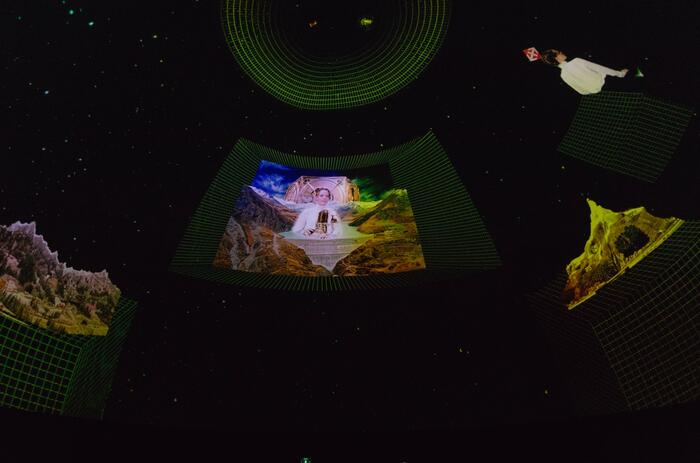
The Venice Biennale 2024 offers an exceptional platform for examining the challenges and opportunities facing the future. The pavilions of Japan, Germany, Switzerland and Hungary trace different forms of looking at and thinking about the world to come, projecting visions of the environment, equilibrium, adaptation, world order and, of course, collective memory.
POSSIBLE FUTURES AT THE VENICE BIENNALE
The Venice Biennale 2024 offers an exceptional platform for examining the challenges and opportunities facing the future. The pavilions of Japan, Germany, Switzerland and Hungary trace different forms of looking at and thinking about the world to come, projecting visions of the environment, equilibrium, adaptation, world order and, of course, collective memory.

The Venice Biennale 2024 offers an exceptional platform for examining the challenges and opportunities facing the future. The pavilions of Japan, Germany, Switzerland and Hungary trace different forms of looking at and thinking about the world to come, projecting visions of the environment, equilibrium, adaptation, world order and, of course, collective memory.
POSSIBLE FUTURES AT THE VENICE BIENNALE
The Venice Biennale 2024 offers an exceptional platform for examining the challenges and opportunities facing the future. The pavilions of Japan, Germany, Switzerland and Hungary trace different forms of looking at and thinking about the world to come, projecting visions of the environment, equilibrium, adaptation, world order and, of course, collective memory.
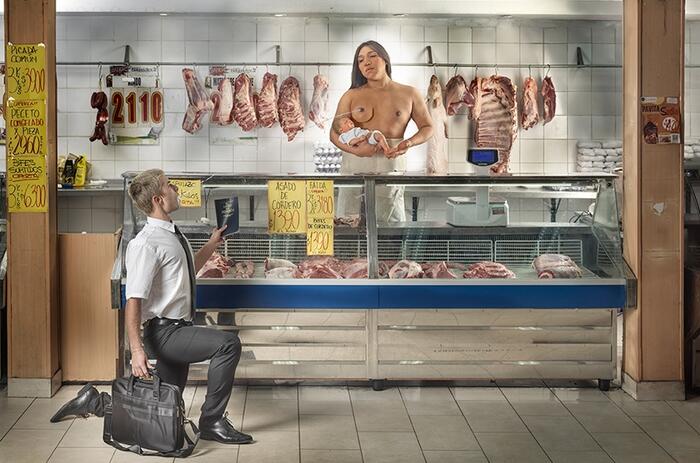
MUDEC in Milan presented the exhibition Guaymallén, by Argentinian artist La Chola Poblete, winner in 2023 of the prestigious international “Artist of the Year” award dedicated by the Deutsche Bank to contemporary art, and who was recently celebrated with a special mention for her contribution to the 60th International Art Exhibition of the Venice Biennale. The exhibition is curated by Britta Färber, Global Head of Art & Culture at the Bank.
LA CHOLA POBLETE IN MILÁN – THE EXHIBITION “GUAYMALLÉN” ARRIVES AT MUDEC
MUDEC in Milan presented the exhibition Guaymallén, by Argentinian artist La Chola Poblete, winner in 2023 of the prestigious international “Artist of the Year” award dedicated by the Deutsche Bank to contemporary art, and who was recently celebrated with a special mention for her contribution to the 60th International Art Exhibition of the Venice Biennale. The exhibition is curated by Britta Färber, Global Head of Art & Culture at the Bank.
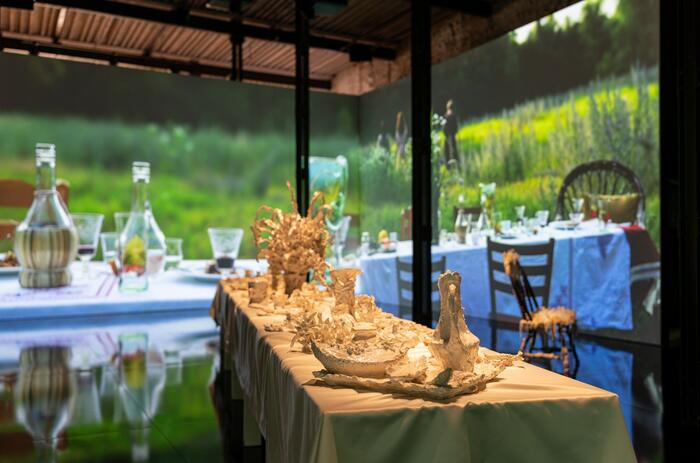
The Mexico Pavilion at the Venice Biennale 2024 proposes an immersive experience that invites the viewer to reflect on the act of migrating and its impact on identity and sense of belonging. As we marched away, we were always coming back is Erick Meyenberg's project curated by Tania Ragasol. It includes elements created in Mexico, Italy and Albania.
THE PATH OF MEMORIES – MEXICO AT THE BIENNALE
The Mexico Pavilion at the Venice Biennale 2024 proposes an immersive experience that invites the viewer to reflect on the act of migrating and its impact on identity and sense of belonging. As we marched away, we were always coming back is Erick Meyenberg's project curated by Tania Ragasol. It includes elements created in Mexico, Italy and Albania.
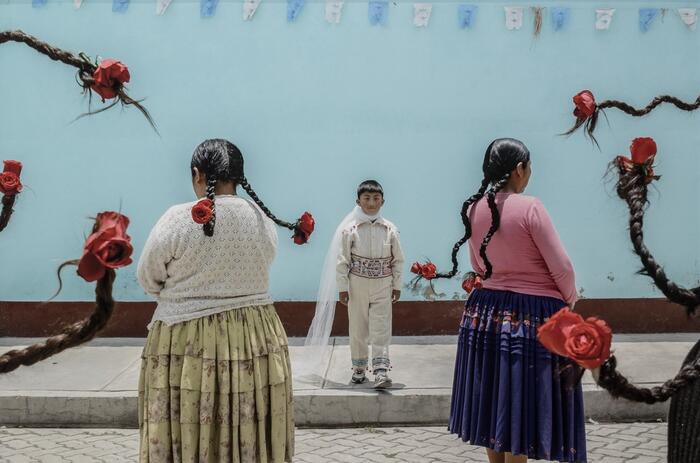
Why highlight stories that often remain on the periphery of artistic discourse? Adriano Pedrosa justifies his curatorial decision with works by 331 artists -mostly from the global south- that open the way to powerful narratives. Finally, we see the axis being twisted. It is difficult to escape the white gaze, more so to move authentically through a Eurocentric space. Given this, the communicative reach of figuration serves to challenge the symbolic order of domination and destabilize the colonial project. The stories that are made explicit and the narratives of magic and everyday life help to recognize without revictimizing.
STORIES FROM THE SOUTH – THE VENICE BIENNALE TURNS AROUND ITS AXIS
Why highlight stories that often remain on the periphery of artistic discourse? Adriano Pedrosa justifies his curatorial decision with works by 331 artists -mostly from the global south- that open the way to powerful narratives. Finally, we see the axis being twisted. It is difficult to escape the white gaze, more so to move authentically through a Eurocentric space. Given this, the communicative reach of figuration serves to challenge the symbolic order of domination and destabilize the colonial project. The stories that are made explicit and the narratives of magic and everyday life help to recognize without revictimizing.
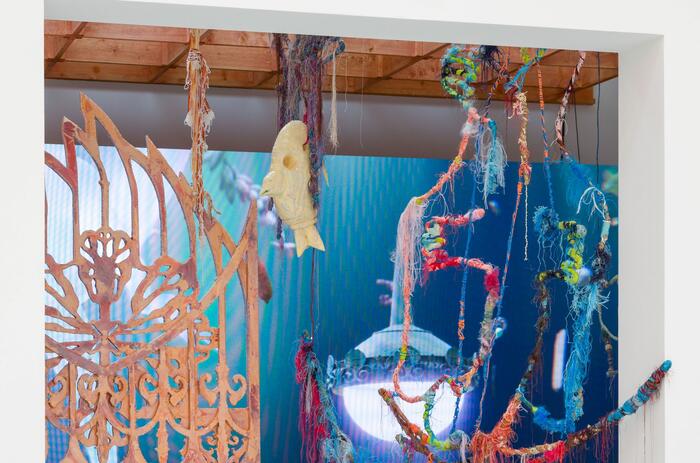
The 2024 Venice Biennale has taken a profound interest on cyclical themes, with water emerging as a dominant motif across exhibitions. In resonance to Pedrosa’s title for this year ‘Stranieri Ovunque’, we see water as a dominant locus for the subjects of travel, shared heritage and fluctuation. On itself, water is seen (as both a vital resource and a destructive force) at the heart of the pavilions representing Greece, France, and in Otero Torres’ Arsenale installation, Aguacero. These exhibitions delve into water’s duality: as a life-giver and a potential destroyer, as a symbol of both division and connection.
WATER, CYCLES AND TRANSFORMATION AT THE VENICE BIENNALE
The 2024 Venice Biennale has taken a profound interest on cyclical themes, with water emerging as a dominant motif across exhibitions. In resonance to Pedrosa’s title for this year ‘Stranieri Ovunque’, we see water as a dominant locus for the subjects of travel, shared heritage and fluctuation. On itself, water is seen (as both a vital resource and a destructive force) at the heart of the pavilions representing Greece, France, and in Otero Torres’ Arsenale installation, Aguacero. These exhibitions delve into water’s duality: as a life-giver and a potential destroyer, as a symbol of both division and connection.
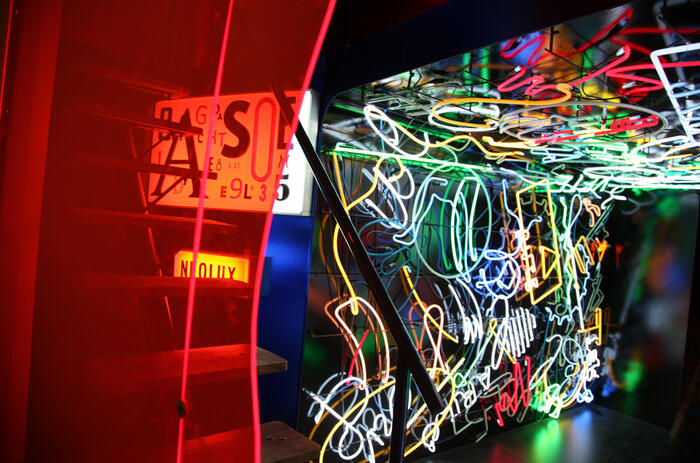
The Museo Moderno announced that La Menesunda, the legendary work by Marta Minujín and Rubén Santantonín –a work originally created in 1965, reconstructed by the Museo de Arte Moderno de Buenos Aires and inaugurated in 2015 and later in 2019 at the New Museum in New York– is on view for the first time in Europe as part of a tour that will show it in four countries.
THE EUROPEAN TOUR OF 'LA MENESUNDA' ACCORDING TO MARTA MINUJÍN
The Museo Moderno announced that La Menesunda, the legendary work by Marta Minujín and Rubén Santantonín –a work originally created in 1965, reconstructed by the Museo de Arte Moderno de Buenos Aires and inaugurated in 2015 and later in 2019 at the New Museum in New York– is on view for the first time in Europe as part of a tour that will show it in four countries.
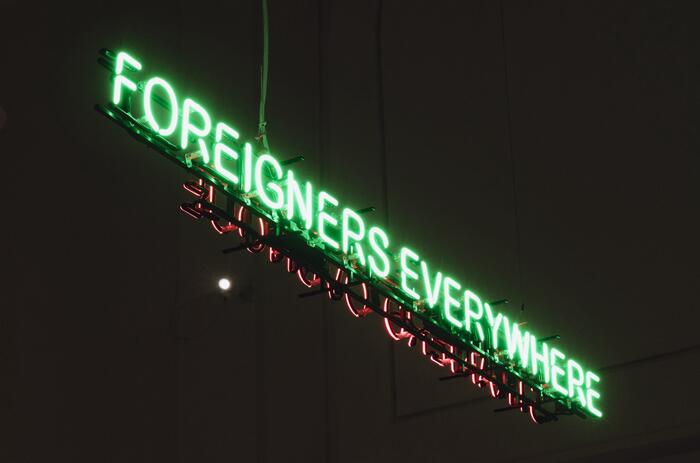
The 2024 edition of the Venice Biennale is coming to an end. Stranieri Ovunque - Foreigners Everywhere, curated by Brazilian Adriano Pedrosa, offered a reflection through art about migration and borders, recurring themes in today's global discussion. Arte al Día was present to cover the 60th International Exhibition, not only to bring the work of more than 300 artists from almost 100 countries, but also to focus on the contribution of Latin American artists to the global scene, whose presence marked a high point in this edition.
VENICE BIENNALE 2024 – LATIN AMERICA EVERYWHERE
The 2024 edition of the Venice Biennale is coming to an end. Stranieri Ovunque - Foreigners Everywhere, curated by Brazilian Adriano Pedrosa, offered a reflection through art about migration and borders, recurring themes in today's global discussion. Arte al Día was present to cover the 60th International Exhibition, not only to bring the work of more than 300 artists from almost 100 countries, but also to focus on the contribution of Latin American artists to the global scene, whose presence marked a high point in this edition.
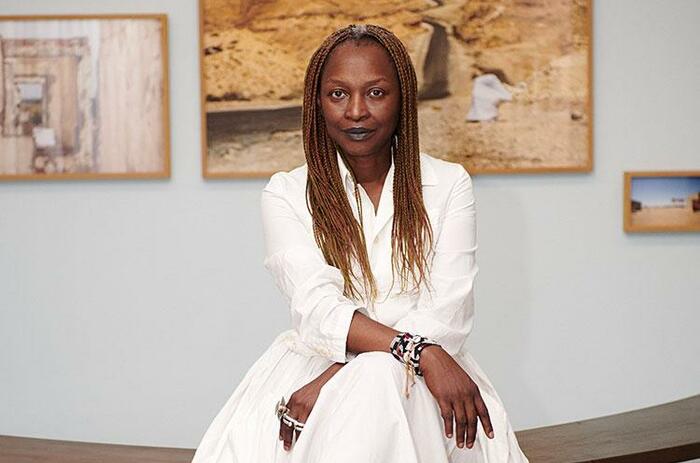
The board of La Biennale di Venezia appointed Koyo Kouoh as Director of the Visual Arts Department, with the specific task of curating the 61st International Art Exhibition to be held in 2026.
KOYO KOUOH IS VENICE BIENNALE 2026’S APPOINTED CURATOR
The board of La Biennale di Venezia appointed Koyo Kouoh as Director of the Visual Arts Department, with the specific task of curating the 61st International Art Exhibition to be held in 2026.

The Venice Biennale 2024 offers an exceptional platform for examining the challenges and opportunities facing the future. The pavilions of Japan, Germany, Switzerland and Hungary trace different forms of looking at and thinking about the world to come, projecting visions of the environment, equilibrium, adaptation, world order and, of course, collective memory.
POSSIBLE FUTURES AT THE VENICE BIENNALE
The Venice Biennale 2024 offers an exceptional platform for examining the challenges and opportunities facing the future. The pavilions of Japan, Germany, Switzerland and Hungary trace different forms of looking at and thinking about the world to come, projecting visions of the environment, equilibrium, adaptation, world order and, of course, collective memory.

MUDEC in Milan presented the exhibition Guaymallén, by Argentinian artist La Chola Poblete, winner in 2023 of the prestigious international “Artist of the Year” award dedicated by the Deutsche Bank to contemporary art, and who was recently celebrated with a special mention for her contribution to the 60th International Art Exhibition of the Venice Biennale. The exhibition is curated by Britta Färber, Global Head of Art & Culture at the Bank.
LA CHOLA POBLETE IN MILÁN – THE EXHIBITION “GUAYMALLÉN” ARRIVES AT MUDEC
MUDEC in Milan presented the exhibition Guaymallén, by Argentinian artist La Chola Poblete, winner in 2023 of the prestigious international “Artist of the Year” award dedicated by the Deutsche Bank to contemporary art, and who was recently celebrated with a special mention for her contribution to the 60th International Art Exhibition of the Venice Biennale. The exhibition is curated by Britta Färber, Global Head of Art & Culture at the Bank.

The Mexico Pavilion at the Venice Biennale 2024 proposes an immersive experience that invites the viewer to reflect on the act of migrating and its impact on identity and sense of belonging. As we marched away, we were always coming back is Erick Meyenberg's project curated by Tania Ragasol. It includes elements created in Mexico, Italy and Albania.
THE PATH OF MEMORIES – MEXICO AT THE BIENNALE
The Mexico Pavilion at the Venice Biennale 2024 proposes an immersive experience that invites the viewer to reflect on the act of migrating and its impact on identity and sense of belonging. As we marched away, we were always coming back is Erick Meyenberg's project curated by Tania Ragasol. It includes elements created in Mexico, Italy and Albania.

Why highlight stories that often remain on the periphery of artistic discourse? Adriano Pedrosa justifies his curatorial decision with works by 331 artists -mostly from the global south- that open the way to powerful narratives. Finally, we see the axis being twisted. It is difficult to escape the white gaze, more so to move authentically through a Eurocentric space. Given this, the communicative reach of figuration serves to challenge the symbolic order of domination and destabilize the colonial project. The stories that are made explicit and the narratives of magic and everyday life help to recognize without revictimizing.
STORIES FROM THE SOUTH – THE VENICE BIENNALE TURNS AROUND ITS AXIS
Why highlight stories that often remain on the periphery of artistic discourse? Adriano Pedrosa justifies his curatorial decision with works by 331 artists -mostly from the global south- that open the way to powerful narratives. Finally, we see the axis being twisted. It is difficult to escape the white gaze, more so to move authentically through a Eurocentric space. Given this, the communicative reach of figuration serves to challenge the symbolic order of domination and destabilize the colonial project. The stories that are made explicit and the narratives of magic and everyday life help to recognize without revictimizing.

The 2024 Venice Biennale has taken a profound interest on cyclical themes, with water emerging as a dominant motif across exhibitions. In resonance to Pedrosa’s title for this year ‘Stranieri Ovunque’, we see water as a dominant locus for the subjects of travel, shared heritage and fluctuation. On itself, water is seen (as both a vital resource and a destructive force) at the heart of the pavilions representing Greece, France, and in Otero Torres’ Arsenale installation, Aguacero. These exhibitions delve into water’s duality: as a life-giver and a potential destroyer, as a symbol of both division and connection.
WATER, CYCLES AND TRANSFORMATION AT THE VENICE BIENNALE
The 2024 Venice Biennale has taken a profound interest on cyclical themes, with water emerging as a dominant motif across exhibitions. In resonance to Pedrosa’s title for this year ‘Stranieri Ovunque’, we see water as a dominant locus for the subjects of travel, shared heritage and fluctuation. On itself, water is seen (as both a vital resource and a destructive force) at the heart of the pavilions representing Greece, France, and in Otero Torres’ Arsenale installation, Aguacero. These exhibitions delve into water’s duality: as a life-giver and a potential destroyer, as a symbol of both division and connection.

The Museo Moderno announced that La Menesunda, the legendary work by Marta Minujín and Rubén Santantonín –a work originally created in 1965, reconstructed by the Museo de Arte Moderno de Buenos Aires and inaugurated in 2015 and later in 2019 at the New Museum in New York– is on view for the first time in Europe as part of a tour that will show it in four countries.
THE EUROPEAN TOUR OF 'LA MENESUNDA' ACCORDING TO MARTA MINUJÍN
The Museo Moderno announced that La Menesunda, the legendary work by Marta Minujín and Rubén Santantonín –a work originally created in 1965, reconstructed by the Museo de Arte Moderno de Buenos Aires and inaugurated in 2015 and later in 2019 at the New Museum in New York– is on view for the first time in Europe as part of a tour that will show it in four countries.

The 2024 edition of the Venice Biennale is coming to an end. Stranieri Ovunque - Foreigners Everywhere, curated by Brazilian Adriano Pedrosa, offered a reflection through art about migration and borders, recurring themes in today's global discussion. Arte al Día was present to cover the 60th International Exhibition, not only to bring the work of more than 300 artists from almost 100 countries, but also to focus on the contribution of Latin American artists to the global scene, whose presence marked a high point in this edition.
VENICE BIENNALE 2024 – LATIN AMERICA EVERYWHERE
The 2024 edition of the Venice Biennale is coming to an end. Stranieri Ovunque - Foreigners Everywhere, curated by Brazilian Adriano Pedrosa, offered a reflection through art about migration and borders, recurring themes in today's global discussion. Arte al Día was present to cover the 60th International Exhibition, not only to bring the work of more than 300 artists from almost 100 countries, but also to focus on the contribution of Latin American artists to the global scene, whose presence marked a high point in this edition.

The board of La Biennale di Venezia appointed Koyo Kouoh as Director of the Visual Arts Department, with the specific task of curating the 61st International Art Exhibition to be held in 2026.
KOYO KOUOH IS VENICE BIENNALE 2026’S APPOINTED CURATOR
The board of La Biennale di Venezia appointed Koyo Kouoh as Director of the Visual Arts Department, with the specific task of curating the 61st International Art Exhibition to be held in 2026.

The Venice Biennale 2024 offers an exceptional platform for examining the challenges and opportunities facing the future. The pavilions of Japan, Germany, Switzerland and Hungary trace different forms of looking at and thinking about the world to come, projecting visions of the environment, equilibrium, adaptation, world order and, of course, collective memory.
POSSIBLE FUTURES AT THE VENICE BIENNALE
The Venice Biennale 2024 offers an exceptional platform for examining the challenges and opportunities facing the future. The pavilions of Japan, Germany, Switzerland and Hungary trace different forms of looking at and thinking about the world to come, projecting visions of the environment, equilibrium, adaptation, world order and, of course, collective memory.

MUDEC in Milan presented the exhibition Guaymallén, by Argentinian artist La Chola Poblete, winner in 2023 of the prestigious international “Artist of the Year” award dedicated by the Deutsche Bank to contemporary art, and who was recently celebrated with a special mention for her contribution to the 60th International Art Exhibition of the Venice Biennale. The exhibition is curated by Britta Färber, Global Head of Art & Culture at the Bank.
LA CHOLA POBLETE IN MILÁN – THE EXHIBITION “GUAYMALLÉN” ARRIVES AT MUDEC
MUDEC in Milan presented the exhibition Guaymallén, by Argentinian artist La Chola Poblete, winner in 2023 of the prestigious international “Artist of the Year” award dedicated by the Deutsche Bank to contemporary art, and who was recently celebrated with a special mention for her contribution to the 60th International Art Exhibition of the Venice Biennale. The exhibition is curated by Britta Färber, Global Head of Art & Culture at the Bank.

The Mexico Pavilion at the Venice Biennale 2024 proposes an immersive experience that invites the viewer to reflect on the act of migrating and its impact on identity and sense of belonging. As we marched away, we were always coming back is Erick Meyenberg's project curated by Tania Ragasol. It includes elements created in Mexico, Italy and Albania.
THE PATH OF MEMORIES – MEXICO AT THE BIENNALE
The Mexico Pavilion at the Venice Biennale 2024 proposes an immersive experience that invites the viewer to reflect on the act of migrating and its impact on identity and sense of belonging. As we marched away, we were always coming back is Erick Meyenberg's project curated by Tania Ragasol. It includes elements created in Mexico, Italy and Albania.

Why highlight stories that often remain on the periphery of artistic discourse? Adriano Pedrosa justifies his curatorial decision with works by 331 artists -mostly from the global south- that open the way to powerful narratives. Finally, we see the axis being twisted. It is difficult to escape the white gaze, more so to move authentically through a Eurocentric space. Given this, the communicative reach of figuration serves to challenge the symbolic order of domination and destabilize the colonial project. The stories that are made explicit and the narratives of magic and everyday life help to recognize without revictimizing.
STORIES FROM THE SOUTH – THE VENICE BIENNALE TURNS AROUND ITS AXIS
Why highlight stories that often remain on the periphery of artistic discourse? Adriano Pedrosa justifies his curatorial decision with works by 331 artists -mostly from the global south- that open the way to powerful narratives. Finally, we see the axis being twisted. It is difficult to escape the white gaze, more so to move authentically through a Eurocentric space. Given this, the communicative reach of figuration serves to challenge the symbolic order of domination and destabilize the colonial project. The stories that are made explicit and the narratives of magic and everyday life help to recognize without revictimizing.

The 2024 Venice Biennale has taken a profound interest on cyclical themes, with water emerging as a dominant motif across exhibitions. In resonance to Pedrosa’s title for this year ‘Stranieri Ovunque’, we see water as a dominant locus for the subjects of travel, shared heritage and fluctuation. On itself, water is seen (as both a vital resource and a destructive force) at the heart of the pavilions representing Greece, France, and in Otero Torres’ Arsenale installation, Aguacero. These exhibitions delve into water’s duality: as a life-giver and a potential destroyer, as a symbol of both division and connection.
WATER, CYCLES AND TRANSFORMATION AT THE VENICE BIENNALE
The 2024 Venice Biennale has taken a profound interest on cyclical themes, with water emerging as a dominant motif across exhibitions. In resonance to Pedrosa’s title for this year ‘Stranieri Ovunque’, we see water as a dominant locus for the subjects of travel, shared heritage and fluctuation. On itself, water is seen (as both a vital resource and a destructive force) at the heart of the pavilions representing Greece, France, and in Otero Torres’ Arsenale installation, Aguacero. These exhibitions delve into water’s duality: as a life-giver and a potential destroyer, as a symbol of both division and connection.

The Museo Moderno announced that La Menesunda, the legendary work by Marta Minujín and Rubén Santantonín –a work originally created in 1965, reconstructed by the Museo de Arte Moderno de Buenos Aires and inaugurated in 2015 and later in 2019 at the New Museum in New York– is on view for the first time in Europe as part of a tour that will show it in four countries.
THE EUROPEAN TOUR OF 'LA MENESUNDA' ACCORDING TO MARTA MINUJÍN
The Museo Moderno announced that La Menesunda, the legendary work by Marta Minujín and Rubén Santantonín –a work originally created in 1965, reconstructed by the Museo de Arte Moderno de Buenos Aires and inaugurated in 2015 and later in 2019 at the New Museum in New York– is on view for the first time in Europe as part of a tour that will show it in four countries.

The 2024 edition of the Venice Biennale is coming to an end. Stranieri Ovunque - Foreigners Everywhere, curated by Brazilian Adriano Pedrosa, offered a reflection through art about migration and borders, recurring themes in today's global discussion. Arte al Día was present to cover the 60th International Exhibition, not only to bring the work of more than 300 artists from almost 100 countries, but also to focus on the contribution of Latin American artists to the global scene, whose presence marked a high point in this edition.
VENICE BIENNALE 2024 – LATIN AMERICA EVERYWHERE
The 2024 edition of the Venice Biennale is coming to an end. Stranieri Ovunque - Foreigners Everywhere, curated by Brazilian Adriano Pedrosa, offered a reflection through art about migration and borders, recurring themes in today's global discussion. Arte al Día was present to cover the 60th International Exhibition, not only to bring the work of more than 300 artists from almost 100 countries, but also to focus on the contribution of Latin American artists to the global scene, whose presence marked a high point in this edition.

The board of La Biennale di Venezia appointed Koyo Kouoh as Director of the Visual Arts Department, with the specific task of curating the 61st International Art Exhibition to be held in 2026.
KOYO KOUOH IS VENICE BIENNALE 2026’S APPOINTED CURATOR
The board of La Biennale di Venezia appointed Koyo Kouoh as Director of the Visual Arts Department, with the specific task of curating the 61st International Art Exhibition to be held in 2026.

The Venice Biennale 2024 offers an exceptional platform for examining the challenges and opportunities facing the future. The pavilions of Japan, Germany, Switzerland and Hungary trace different forms of looking at and thinking about the world to come, projecting visions of the environment, equilibrium, adaptation, world order and, of course, collective memory.
POSSIBLE FUTURES AT THE VENICE BIENNALE
The Venice Biennale 2024 offers an exceptional platform for examining the challenges and opportunities facing the future. The pavilions of Japan, Germany, Switzerland and Hungary trace different forms of looking at and thinking about the world to come, projecting visions of the environment, equilibrium, adaptation, world order and, of course, collective memory.

MUDEC in Milan presented the exhibition Guaymallén, by Argentinian artist La Chola Poblete, winner in 2023 of the prestigious international “Artist of the Year” award dedicated by the Deutsche Bank to contemporary art, and who was recently celebrated with a special mention for her contribution to the 60th International Art Exhibition of the Venice Biennale. The exhibition is curated by Britta Färber, Global Head of Art & Culture at the Bank.
LA CHOLA POBLETE IN MILÁN – THE EXHIBITION “GUAYMALLÉN” ARRIVES AT MUDEC
MUDEC in Milan presented the exhibition Guaymallén, by Argentinian artist La Chola Poblete, winner in 2023 of the prestigious international “Artist of the Year” award dedicated by the Deutsche Bank to contemporary art, and who was recently celebrated with a special mention for her contribution to the 60th International Art Exhibition of the Venice Biennale. The exhibition is curated by Britta Färber, Global Head of Art & Culture at the Bank.

The Mexico Pavilion at the Venice Biennale 2024 proposes an immersive experience that invites the viewer to reflect on the act of migrating and its impact on identity and sense of belonging. As we marched away, we were always coming back is Erick Meyenberg's project curated by Tania Ragasol. It includes elements created in Mexico, Italy and Albania.
THE PATH OF MEMORIES – MEXICO AT THE BIENNALE
The Mexico Pavilion at the Venice Biennale 2024 proposes an immersive experience that invites the viewer to reflect on the act of migrating and its impact on identity and sense of belonging. As we marched away, we were always coming back is Erick Meyenberg's project curated by Tania Ragasol. It includes elements created in Mexico, Italy and Albania.

Why highlight stories that often remain on the periphery of artistic discourse? Adriano Pedrosa justifies his curatorial decision with works by 331 artists -mostly from the global south- that open the way to powerful narratives. Finally, we see the axis being twisted. It is difficult to escape the white gaze, more so to move authentically through a Eurocentric space. Given this, the communicative reach of figuration serves to challenge the symbolic order of domination and destabilize the colonial project. The stories that are made explicit and the narratives of magic and everyday life help to recognize without revictimizing.
STORIES FROM THE SOUTH – THE VENICE BIENNALE TURNS AROUND ITS AXIS
Why highlight stories that often remain on the periphery of artistic discourse? Adriano Pedrosa justifies his curatorial decision with works by 331 artists -mostly from the global south- that open the way to powerful narratives. Finally, we see the axis being twisted. It is difficult to escape the white gaze, more so to move authentically through a Eurocentric space. Given this, the communicative reach of figuration serves to challenge the symbolic order of domination and destabilize the colonial project. The stories that are made explicit and the narratives of magic and everyday life help to recognize without revictimizing.

The 2024 Venice Biennale has taken a profound interest on cyclical themes, with water emerging as a dominant motif across exhibitions. In resonance to Pedrosa’s title for this year ‘Stranieri Ovunque’, we see water as a dominant locus for the subjects of travel, shared heritage and fluctuation. On itself, water is seen (as both a vital resource and a destructive force) at the heart of the pavilions representing Greece, France, and in Otero Torres’ Arsenale installation, Aguacero. These exhibitions delve into water’s duality: as a life-giver and a potential destroyer, as a symbol of both division and connection.
WATER, CYCLES AND TRANSFORMATION AT THE VENICE BIENNALE
The 2024 Venice Biennale has taken a profound interest on cyclical themes, with water emerging as a dominant motif across exhibitions. In resonance to Pedrosa’s title for this year ‘Stranieri Ovunque’, we see water as a dominant locus for the subjects of travel, shared heritage and fluctuation. On itself, water is seen (as both a vital resource and a destructive force) at the heart of the pavilions representing Greece, France, and in Otero Torres’ Arsenale installation, Aguacero. These exhibitions delve into water’s duality: as a life-giver and a potential destroyer, as a symbol of both division and connection.

The Museo Moderno announced that La Menesunda, the legendary work by Marta Minujín and Rubén Santantonín –a work originally created in 1965, reconstructed by the Museo de Arte Moderno de Buenos Aires and inaugurated in 2015 and later in 2019 at the New Museum in New York– is on view for the first time in Europe as part of a tour that will show it in four countries.
THE EUROPEAN TOUR OF 'LA MENESUNDA' ACCORDING TO MARTA MINUJÍN
The Museo Moderno announced that La Menesunda, the legendary work by Marta Minujín and Rubén Santantonín –a work originally created in 1965, reconstructed by the Museo de Arte Moderno de Buenos Aires and inaugurated in 2015 and later in 2019 at the New Museum in New York– is on view for the first time in Europe as part of a tour that will show it in four countries.

The 2024 edition of the Venice Biennale is coming to an end. Stranieri Ovunque - Foreigners Everywhere, curated by Brazilian Adriano Pedrosa, offered a reflection through art about migration and borders, recurring themes in today's global discussion. Arte al Día was present to cover the 60th International Exhibition, not only to bring the work of more than 300 artists from almost 100 countries, but also to focus on the contribution of Latin American artists to the global scene, whose presence marked a high point in this edition.
VENICE BIENNALE 2024 – LATIN AMERICA EVERYWHERE
The 2024 edition of the Venice Biennale is coming to an end. Stranieri Ovunque - Foreigners Everywhere, curated by Brazilian Adriano Pedrosa, offered a reflection through art about migration and borders, recurring themes in today's global discussion. Arte al Día was present to cover the 60th International Exhibition, not only to bring the work of more than 300 artists from almost 100 countries, but also to focus on the contribution of Latin American artists to the global scene, whose presence marked a high point in this edition.

The board of La Biennale di Venezia appointed Koyo Kouoh as Director of the Visual Arts Department, with the specific task of curating the 61st International Art Exhibition to be held in 2026.
KOYO KOUOH IS VENICE BIENNALE 2026’S APPOINTED CURATOR
The board of La Biennale di Venezia appointed Koyo Kouoh as Director of the Visual Arts Department, with the specific task of curating the 61st International Art Exhibition to be held in 2026.

The Venice Biennale 2024 offers an exceptional platform for examining the challenges and opportunities facing the future. The pavilions of Japan, Germany, Switzerland and Hungary trace different forms of looking at and thinking about the world to come, projecting visions of the environment, equilibrium, adaptation, world order and, of course, collective memory.
POSSIBLE FUTURES AT THE VENICE BIENNALE
The Venice Biennale 2024 offers an exceptional platform for examining the challenges and opportunities facing the future. The pavilions of Japan, Germany, Switzerland and Hungary trace different forms of looking at and thinking about the world to come, projecting visions of the environment, equilibrium, adaptation, world order and, of course, collective memory.

MUDEC in Milan presented the exhibition Guaymallén, by Argentinian artist La Chola Poblete, winner in 2023 of the prestigious international “Artist of the Year” award dedicated by the Deutsche Bank to contemporary art, and who was recently celebrated with a special mention for her contribution to the 60th International Art Exhibition of the Venice Biennale. The exhibition is curated by Britta Färber, Global Head of Art & Culture at the Bank.
LA CHOLA POBLETE IN MILÁN – THE EXHIBITION “GUAYMALLÉN” ARRIVES AT MUDEC
MUDEC in Milan presented the exhibition Guaymallén, by Argentinian artist La Chola Poblete, winner in 2023 of the prestigious international “Artist of the Year” award dedicated by the Deutsche Bank to contemporary art, and who was recently celebrated with a special mention for her contribution to the 60th International Art Exhibition of the Venice Biennale. The exhibition is curated by Britta Färber, Global Head of Art & Culture at the Bank.

The Mexico Pavilion at the Venice Biennale 2024 proposes an immersive experience that invites the viewer to reflect on the act of migrating and its impact on identity and sense of belonging. As we marched away, we were always coming back is Erick Meyenberg's project curated by Tania Ragasol. It includes elements created in Mexico, Italy and Albania.
THE PATH OF MEMORIES – MEXICO AT THE BIENNALE
The Mexico Pavilion at the Venice Biennale 2024 proposes an immersive experience that invites the viewer to reflect on the act of migrating and its impact on identity and sense of belonging. As we marched away, we were always coming back is Erick Meyenberg's project curated by Tania Ragasol. It includes elements created in Mexico, Italy and Albania.

Why highlight stories that often remain on the periphery of artistic discourse? Adriano Pedrosa justifies his curatorial decision with works by 331 artists -mostly from the global south- that open the way to powerful narratives. Finally, we see the axis being twisted. It is difficult to escape the white gaze, more so to move authentically through a Eurocentric space. Given this, the communicative reach of figuration serves to challenge the symbolic order of domination and destabilize the colonial project. The stories that are made explicit and the narratives of magic and everyday life help to recognize without revictimizing.
STORIES FROM THE SOUTH – THE VENICE BIENNALE TURNS AROUND ITS AXIS
Why highlight stories that often remain on the periphery of artistic discourse? Adriano Pedrosa justifies his curatorial decision with works by 331 artists -mostly from the global south- that open the way to powerful narratives. Finally, we see the axis being twisted. It is difficult to escape the white gaze, more so to move authentically through a Eurocentric space. Given this, the communicative reach of figuration serves to challenge the symbolic order of domination and destabilize the colonial project. The stories that are made explicit and the narratives of magic and everyday life help to recognize without revictimizing.

The 2024 Venice Biennale has taken a profound interest on cyclical themes, with water emerging as a dominant motif across exhibitions. In resonance to Pedrosa’s title for this year ‘Stranieri Ovunque’, we see water as a dominant locus for the subjects of travel, shared heritage and fluctuation. On itself, water is seen (as both a vital resource and a destructive force) at the heart of the pavilions representing Greece, France, and in Otero Torres’ Arsenale installation, Aguacero. These exhibitions delve into water’s duality: as a life-giver and a potential destroyer, as a symbol of both division and connection.
WATER, CYCLES AND TRANSFORMATION AT THE VENICE BIENNALE
The 2024 Venice Biennale has taken a profound interest on cyclical themes, with water emerging as a dominant motif across exhibitions. In resonance to Pedrosa’s title for this year ‘Stranieri Ovunque’, we see water as a dominant locus for the subjects of travel, shared heritage and fluctuation. On itself, water is seen (as both a vital resource and a destructive force) at the heart of the pavilions representing Greece, France, and in Otero Torres’ Arsenale installation, Aguacero. These exhibitions delve into water’s duality: as a life-giver and a potential destroyer, as a symbol of both division and connection.

The Museo Moderno announced that La Menesunda, the legendary work by Marta Minujín and Rubén Santantonín –a work originally created in 1965, reconstructed by the Museo de Arte Moderno de Buenos Aires and inaugurated in 2015 and later in 2019 at the New Museum in New York– is on view for the first time in Europe as part of a tour that will show it in four countries.
THE EUROPEAN TOUR OF 'LA MENESUNDA' ACCORDING TO MARTA MINUJÍN
The Museo Moderno announced that La Menesunda, the legendary work by Marta Minujín and Rubén Santantonín –a work originally created in 1965, reconstructed by the Museo de Arte Moderno de Buenos Aires and inaugurated in 2015 and later in 2019 at the New Museum in New York– is on view for the first time in Europe as part of a tour that will show it in four countries.

The 2024 edition of the Venice Biennale is coming to an end. Stranieri Ovunque - Foreigners Everywhere, curated by Brazilian Adriano Pedrosa, offered a reflection through art about migration and borders, recurring themes in today's global discussion. Arte al Día was present to cover the 60th International Exhibition, not only to bring the work of more than 300 artists from almost 100 countries, but also to focus on the contribution of Latin American artists to the global scene, whose presence marked a high point in this edition.
VENICE BIENNALE 2024 – LATIN AMERICA EVERYWHERE
The 2024 edition of the Venice Biennale is coming to an end. Stranieri Ovunque - Foreigners Everywhere, curated by Brazilian Adriano Pedrosa, offered a reflection through art about migration and borders, recurring themes in today's global discussion. Arte al Día was present to cover the 60th International Exhibition, not only to bring the work of more than 300 artists from almost 100 countries, but also to focus on the contribution of Latin American artists to the global scene, whose presence marked a high point in this edition.

The board of La Biennale di Venezia appointed Koyo Kouoh as Director of the Visual Arts Department, with the specific task of curating the 61st International Art Exhibition to be held in 2026.
KOYO KOUOH IS VENICE BIENNALE 2026’S APPOINTED CURATOR
The board of La Biennale di Venezia appointed Koyo Kouoh as Director of the Visual Arts Department, with the specific task of curating the 61st International Art Exhibition to be held in 2026.




